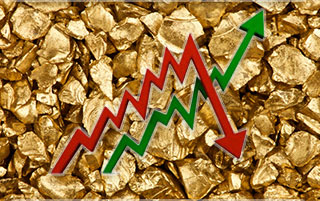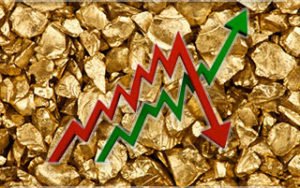The price of gold has seen a great decline in the past few weeks. Gold has closed down in 7 of the last 8 market sessions, sending some mining stocks down. But this is merely a sign that the Fed will finally raise rates this year, probably in December before year’s end. Gold, which is a non-interest bearing asset, tends to lose ground whenever interest rates increase. Nevertheless, it is important to understand the wider context of the markets to properly assess whether or not the lower prices represent an opportunity to buy, or whether the price of this commodity is closer to a more prolonged bear market.
The first aspect to consider under the current state of affairs in the global economy, is the fact that despite a likely Fed hike before year’s end, interest rates are holding at historic lows. If the rate hike goes through, it will be a 25 basis points increase, putting the overnight rates at 0.75%. That would still be a very low yielding environment, and with the Fed reluctant to tighten monetary policy faster, the world can well get stuck at that low rate for at least another year. So despite higher rates, gold should still have a place within a global context of low yields, especially given the rates elsewhere – negative in Japan and the EU.
The second aspect to consider is the global economic weakness that central banks have seen as forcing their hand into a lower for longer monetary strategy. The IMF recently lowered its outlook for various leading world economies, and placed global GDP growth for 2016 at a meagre 3.1%. IMF projections show a weak 2017 as well, with a mere improvement in global GDP growth of 0.3% for a 2017 global GDP growth forecast of 3.4%. This outlook will add to the drag on monetary policy normalization, and will drive investors towards safe havens like gold because the global economy will remain fragile.
In fact, these projections show that the world is only one wild card away from a more precarious situation in which global GDP growth could well go below the 3% mark. A range of political events, from the US election to how Brexit is perceived, could generate further drag. There are some other international flash points that could also exacerbate the situation. The war on ISIS, Russian confrontation with NATO allies in a variety of places, particularly Eastern Europe, more instability elsewhere in the Middle East and even tensions between North Korea and its neighbors, could definitely send a weak global economy into a tail spin. The result of which will clearly be, among others, higher gold prices.
Therefore the dip in gold prices is a great chance for investors to re-assess their hedging strategies. They must pay heed to all the information, and keep an eye on gold prices. They might find that the decline in gold prices will soon come to a halt, creating an opportunity to increase their holdings.





